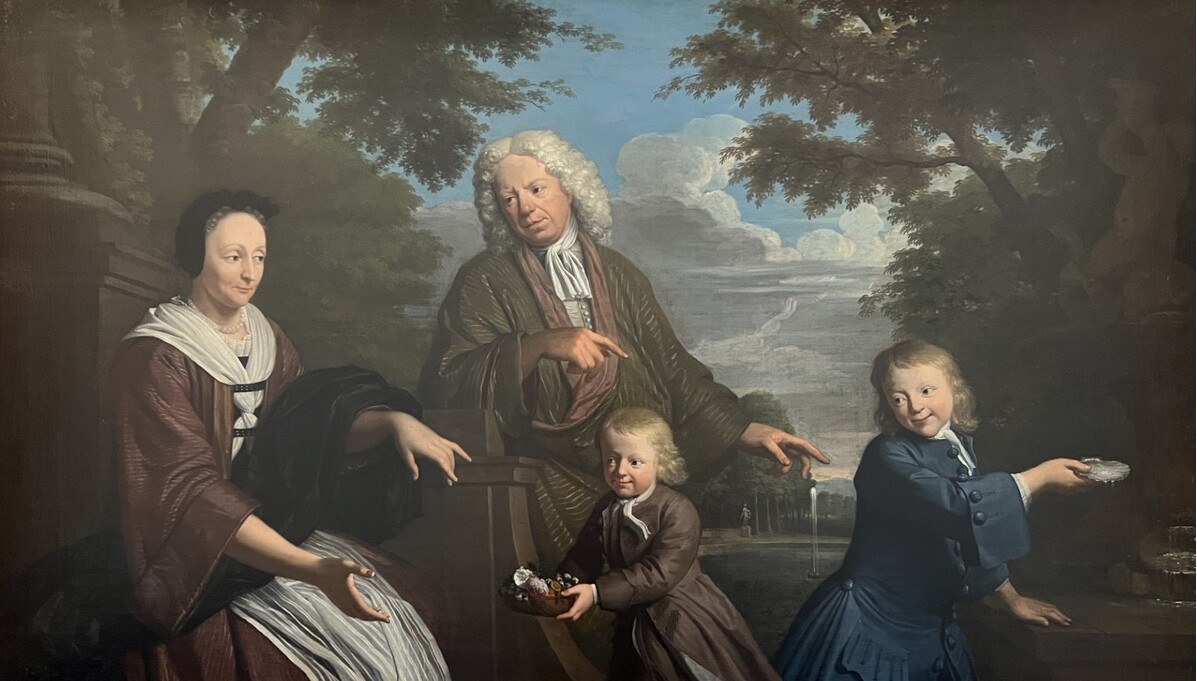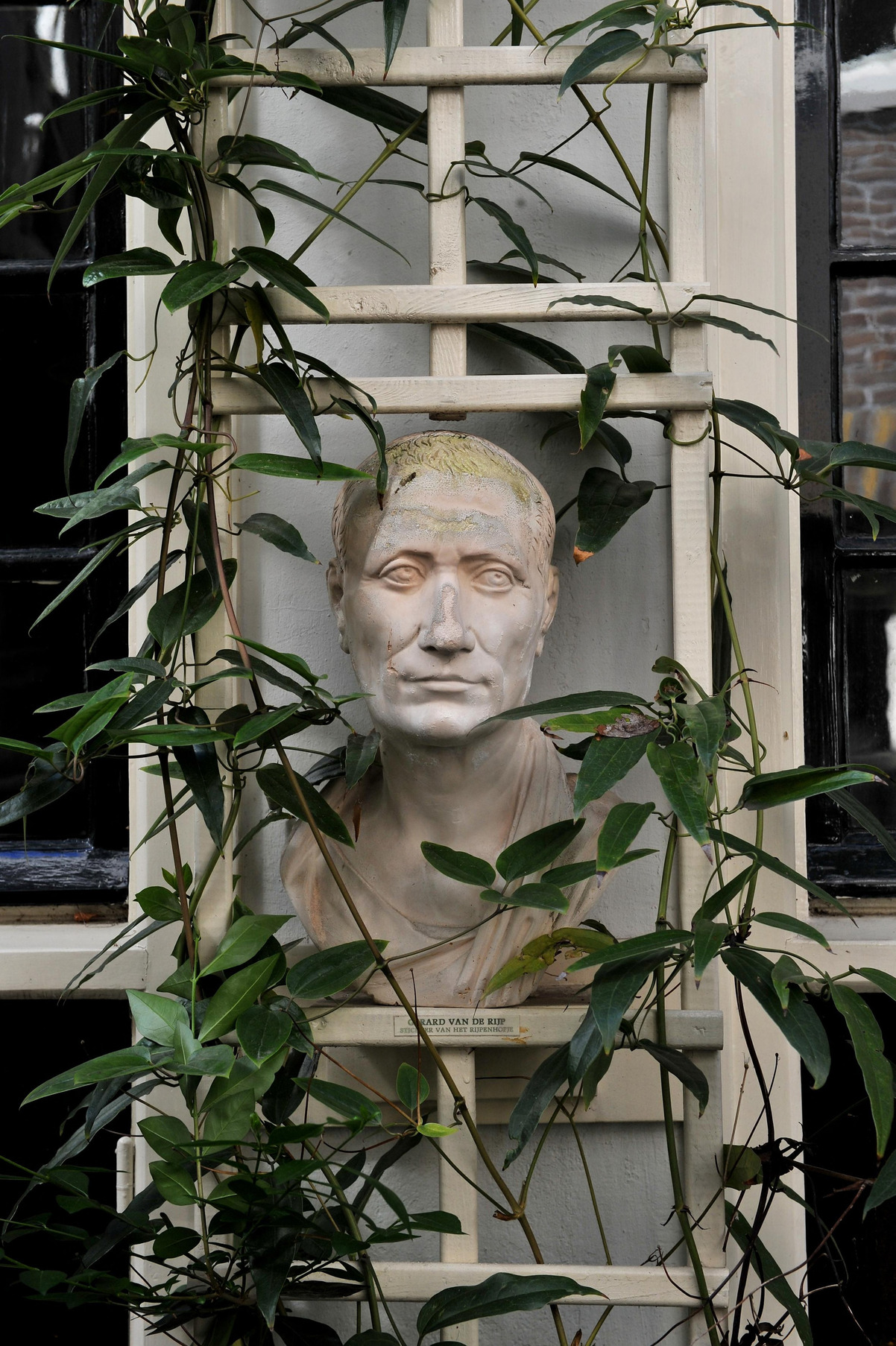The two playful boys portrayed here with their parents grew up to be the first regents of the Rijpenhofje. This family portrait is one of ten paintings that were eventually donated to the hofje by a descendant.
Location
Rijpenhofje
Rozengracht 126
Type
Hofje
Religious community
Doopsgezind Amsterdam (Mennonites)
Object
Portrait of the family Van de Rijp-Centen
Maker and date
Christoffel Lubieniecki
1721
Visit
The portrait is on display in the Singelkerk
The Rijpenhofje
In early modern times, each church denomination needed to care for its own vulnerable communities, and hofjes for housing elderly, poor, and orphans were a part of the structure that congregations used in order to do so. Amsterdam’s various Mennonite groups owned hofjes and other properties for this purpose all over the canal belt and the Jordaan.
In his will from 1733, Gerard van de Rijp (d. 1735) named his nephews Jan and Jacob van de Rijp Centen as his heirs on the condition that they use 20, 000 guilders of this inheritance to found a hofje and make further funds available to support the residents. The nephews followed their uncle’s instructions, founding the Rijpenhofje on the Rozengracht and serving as its first regents. Houses were purchased in 1736, and the hofje was ready for use as a home for elderly women a year later. In 1747, the title for the hofje was officially transferred over to the united Lam and Toren congregation.
In a portrait from 1721 by polish painter Christoffel Lubieniecki, Jan and Jacob van de Rijp-Centen are shown as small children playing cheerfully between their seated parents, Maria van de Rijp and Gozewijn Centen. This painting, now in Doopsgezind Amsterdam’s collection, is one of ten paintings donated to the Rijpenhofje in 1832 by Veronica van de Rijp Centen (1740-1832), who was a niece of Jan.
Doopsgezind Amsterdam (formerly VDGA)
Amsterdam’s Mennonite congregation is known today as Doopsgezind Amsterdam. After centuries of divisions and schisms among the Mennonites, during which time the more conservative groups tended to prefer the name Mennoniet [Mennonite] while the more progressive groups went by Doopsgezind [“Baptism community” or “Baptism-minded”], the congregations united in 1801 as the Verenigde Doopsgezinde Gemeente van Amsterdam (VDGA) [United Mennonite Congregation of Amsterdam]. Today, Doopsgezind Amsterdam is comprised of the Singelkerk (at the 17th-century Kerk bij ’t Lam location) and the 19th-century Meerpadkerk in Noord.
Hofje
A hofje is a partly enclosed residential community intended for the needy, such as orphans and widows, usually consisting of a number of small houses arranged around a courtyard or garden. In the early modern period, each religious group in Amsterdam was responsible for caring for its own poor. As a result, the city has a large number of hofjes with various religious backgrounds.
The Rijpenhofje has been substantially renovated over the years. It was first expanded in in 1830 with the addition of existing houses on the Rozengracht. Between 1910-1913 the hofje was rebuilt after it had fallen into disrepair. This renovation incorporated various design components with Art Nouveau and Art Deco characteristics at this point in time on the cusp of the Amsterdamse School period. Examples include the decorated gated entryway and fountain by Abraham Salm, who also designed the monumental aquarium at Artis and the Mennonite Oosterparkkerk which opened in 1904 (since 1975 in use by the Gereformeerde Kerk). A bust on the premises continues to pay tribute to Gerard van de Rijp’s role and legacy in establishing the hofje.
At present, the hofje still offers housing for single people (now both men and women) over the age of 55 with connections to Amsterdam’s Mennonite community. There are nine rooms for residents and three rooms for students who work as property managers. Since 1965, nine more residents have also lived on the adjoining premises of the Huizen De Lely (Bloemstraat 129-141), which were originally bequeathed from the estate of L.T. Vogel to Amsterdam’s Mennonite congregation in order to house couples aged 60 and over in 1872.
Nina Schroeder-van 't Schip
Independent Scholar, Art Historian & Mennonite Heritage Specialist
Last edited
October 23, 2025
Family portrait of Gozewijn Centen, Maria van de Rijp, and their children Jan Centen (left) and Jacob van de Rijp-Centen (right), Christoffel Lubienietski, 1721, oil on canvas, 94.5 x 161.5 cm. Collection of Doopsgezind Amsterdam.
Exterior: photography Our Lord in the Attic Museum.
Architectural drawing of pergola with fountain for Rijpenhofje [Ontwerptekening met aanzicht van de pergola met bron], Abraham G. Salm (1857-1915), 1913, drawing. Archief van G.B. Salem en A. Salm Gbzn. Stadsarchief Amsterdam.
Bust of Gerard van de Rijp/Founder of the Rijpenhofje [Stichter van het Rijpenhofje], on site at Rijpenhofje. Photograph Albers Martin, City Archive Amsterdam.
Doopsgezind Amsterdam, Monumental erfgoed: Doopsgezind Amsterdam (Amsterdam: Doopsgezind Amsterdam 2025).
Margriet van Eikema Hommes, et al., “The Hidden Youth of Dirck Jacobsz Leeuw: A Portrait by Govert Flinck Revealed,” The Rijksmuseum Bulletin 64 (2016) 5-61.
Online sources
Global Anabaptist Mennonite Encyclopedia Online: Family Van de Rijp
Last visited 22-10-2025
Global Anabaptist Mennonite Encyclopedia Online: Family Centen
Last visited 22-10-2025
Global Anabaptist Mennonite Encyclopedia Online: Amsterdam (Noord-Holland, Netherlands)
Last visited 22-10-2025
Online Catalogus Rijksmuseum: Portret van een man, mogelijk Gozen Centen (1611/12-1677)
Last visited 22-10-2025







